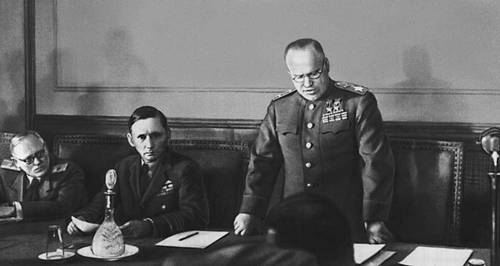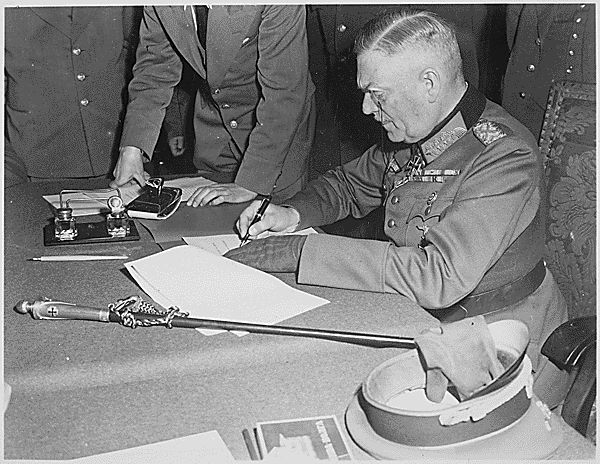| By mid-April of 1945, the armies
of Russia in the East and the United States, England and France in the
West were moving toward Berlin. Confronting certain defeat, Hitler committed
suicide on April 30. On May 2 the Soviets entered Berlin, and German forces
in Italy surrendered.
The First Act of Military Surrender
- Rheims: May 7, 1945
Eisenhower insisted that the Germans
surrender to the Western Allies and the Soviets at the same time. Gen.
Alfred Jodl, Chief of Staff of the German Army, signed the unconditional
surrender of the German Third Reich on May 7,
1945 (which would come to be known
as V-E Day, short for Victory in Europe Day), at Supreme Headquarters,
Allied Expeditionary Force (SHAEF), in Rheims, France. At the same time,
Jodi signed three other surrender documents, one each for Great Britain,
France, and the Soviet Union. Lt. Gen. Walter Bedell Smith, SHAEF
chief of staff, led the Allied delegation as the representative of General
Eisenhower, who refused to meet with the Germans until after the surrender.
The Second Act of Military Surrender
- Berlin: May 8, 1945
The Soviet Union's only representative
in Rheims was General Ivan Susloparov, the Military Liaison Mission Commander.
General Susloparov's scope of authority was not entirely clear, and he
had no means of immediate contact with Kremlin, but nevertheless decided
to risk signing for the Soviet side. However, he noted that it could be
replaced with a new version in the future. Stalin was indeed displeased
by these events. He believed that the German surrender should have been
accepted only by the envoy of the USSR Supreme command, and insisted the
Rheims protocol be considered preliminary, with the main ceremony to be
held in Berlin, where Marshal Zhukov was at the time.
The second Act of Military Surrender
was signed, shortly before midnight, on May 8 in one the outskirts of Berlin.
The representatives of the USSR, Great Britain, France and the United States
arrived shortly before midnight. After Zhukov opened the ceremony, the
German command representatives headed by Wilhelm Keitel were invited into
the room, where they signed the final German Act of Unconditional Surrender
entering into force at 23:01 Central European Time.
The Soviets insisted that the official
Act of Military Surrender be signed at Berlin on the following day, and
the Americans, based on a prior agreement, participated in that ceremony
as well. The documents that the Germans signed in Rheims and Berlin, both
of which called for unconditional surrender, ended the war in Europe.
|


